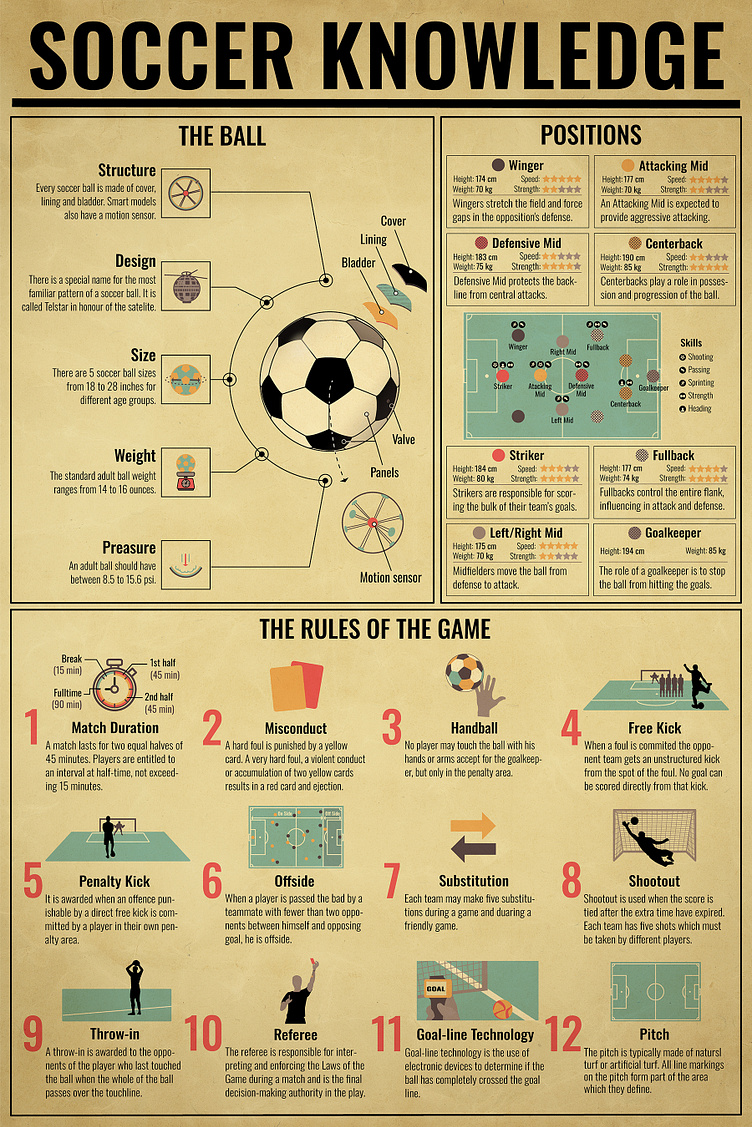
Soccer Knowledge: A Beginner’s Guide to the Basics
Soccer’s universal appeal lies in its simplicity and inclusivity. Whether it’s a local street game or a high-stakes World Cup match, the principles of the game remain the same. The infographic provides an excellent starting point for understanding soccer, offering insights into its technical, strategic, and cultural dimensions.
Introduction: The Universal Language of Soccer
Soccer, or football as it’s known outside the U.S., is often called “The Beautiful Game.” Its simplicity, combined with its global reach, has made it the most popular sport in the world. For those new to the sport, understanding the fundamental elements—ranging from the ball’s design to player positions and rules—is the first step toward truly appreciating the game. This infographic breaks down the essentials of soccer, offering a concise yet comprehensive guide for beginners.
The Ball: Engineering Behind the Game
A soccer ball is more than just a piece of equipment; it’s a marvel of design tailored to ensure consistency and fairness. Each ball consists of several key parts: a cover, a lining, and a bladder. Advanced models even include motion sensors, helping officials make more precise decisions during games.
The design of the soccer ball has evolved over the years, with the iconic Telstar pattern serving as a tribute to soccer’s history. The ball comes in five different sizes, ranging from 18 to 28 inches, catering to different age groups. For adult matches, the ball weighs between 14 to 16 ounces and is inflated to a pressure of 8.5 to 15.6 psi, striking a perfect balance between playability and safety.
Player Positions: The Team’s Engine
Soccer positions are as strategic as they are diverse, each requiring a unique blend of physical and technical skills. Here’s a breakdown of key positions and their roles:
- Winger: Fast and agile, wingers stretch the field and exploit gaps in the defense.
- Striker: The team’s primary goal scorer, strikers are physically strong and technically sharp.
- Midfielders (Left/Right/Defensive): These players act as the team’s glue, transitioning the ball between defense and attack. Defensive midfielders protect the backline, while attacking midfielders are creative playmakers.
- Fullbacks: Responsible for shutting down opposition attacks while supporting offensive plays.
- Goalkeeper: The only player allowed to use their hands, goalkeepers are the last line of defense.
Each player’s effectiveness depends on a combination of speed, stamina, strength, and skill, with these attributes differing based on their position.
Rules of the Game: Simplicity Meets Strategy
At its core, soccer is a simple game, but its rules add depth and strategy. Matches are split into two halves of 45 minutes each, with a 15-minute halftime break. Here are the foundational rules:
- Misconduct: Players committing fouls receive yellow cards as warnings, with a second yellow resulting in a red card and ejection.
- Handball: Players cannot use their hands unless they’re the goalkeeper inside the penalty area.
- Offside: A player is offside if they are closer to the opponent’s goal than the ball and the second-last defender when the ball is passed to them.
- Free Kick and Penalty Kick: Awarded for fouls, with penalties taken from 12 yards out if the offense occurs inside the box.
- Throw-ins and Substitutions: Throw-ins restart play after the ball crosses the sideline, and teams are allowed up to five substitutions in a match.
- Goal-line Technology: Modern technology ensures accurate decisions on whether the ball has fully crossed the goal line.
These rules ensure fair play while adding layers of tactics that keep the game thrilling.
The Magic of Soccer
Soccer’s universal appeal lies in its simplicity and inclusivity. Whether it’s a local street game or a high-stakes World Cup match, the principles of the game remain the same. The infographic provides an excellent starting point for understanding soccer, offering insights into its technical, strategic, and cultural dimensions.
As the sport continues to evolve—with technologies like goal-line sensors and advanced ball designs—the essence of soccer remains untouched: teamwork, passion, and the joy of the game. Whether you’re a player, coach, or fan, mastering the basics is your gateway to enjoying this timeless sport







